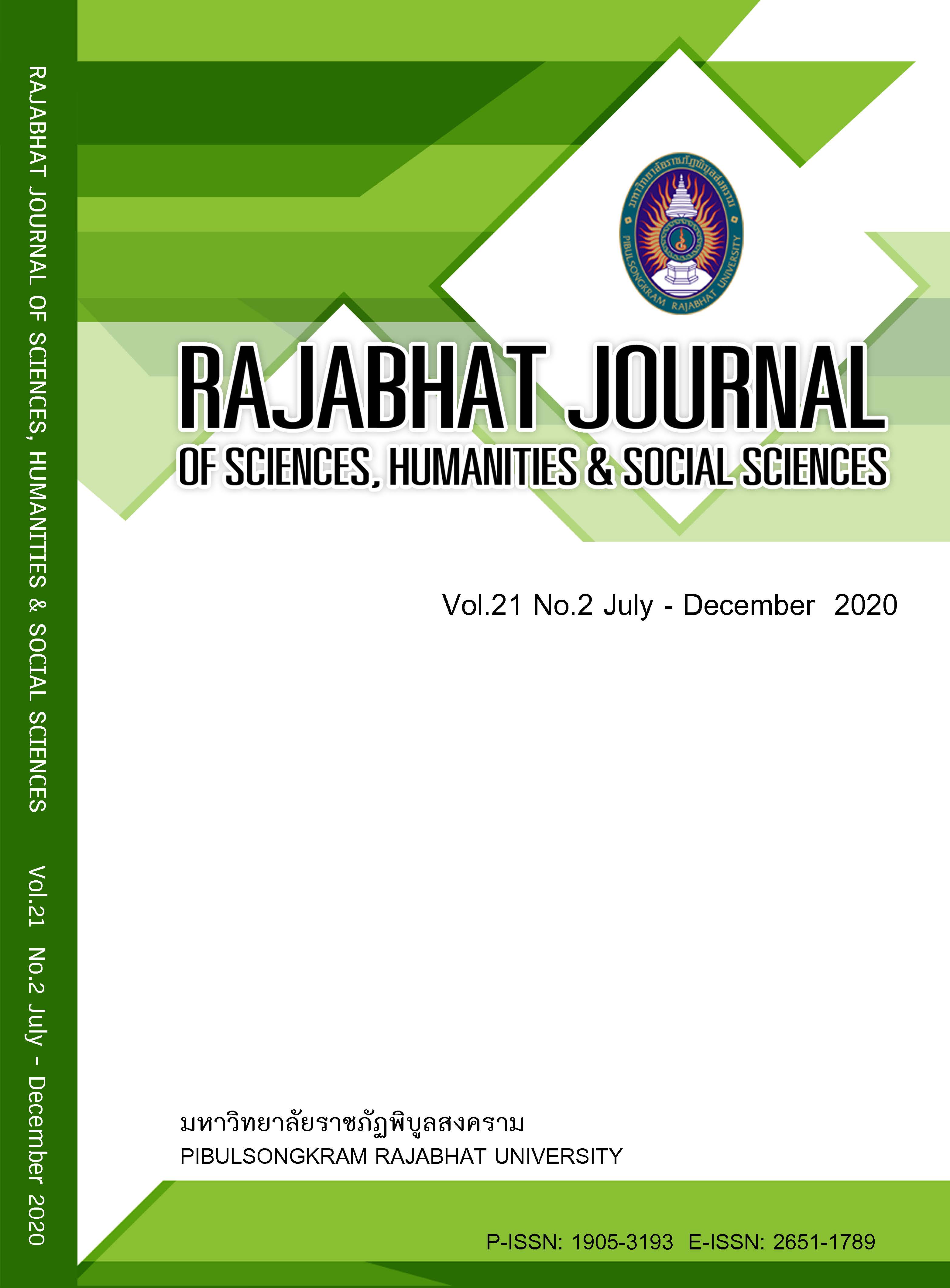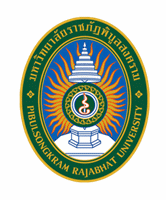ผลของการใช้แป้งกล้วยหินทดแทนแป้งสาลีบางส่วนที่มีต่อคุณภาพ ทางกายภาพและคุณภาพทางประสาทสัมผัสของขนมปังขาไก่
คำสำคัญ:
แป้งกล้วย, กล้วยหิน, ขนมปังขาไก่, แป้งสาลี, แป้งทนการย่อยบทคัดย่อ
งานวิจัยนี้มีวัตถุประสงค์เพื่อศึกษาผลการทดแทนแป้งสาลีด้วยแป้งกล้วยหินในผลิตภัณฑ์ขนมปังขาไก่ เริ่มจากการนำกล้วยหินดิบมาปอกเปลือก ล้างด้วยสารละลายกรดซิตริกที่มีความเข้มข้นร้อยละ 0.3 (น้ำหนักโดยปริมาตร) สไลด์เป็นแผ่นบาง ๆ หนาประมาณ 2-3 มิลลิเมตร นำไปแช่ในสารละลายกรดซิตริกที่มีความเข้มข้นร้อยละ 0.3 (น้ำหนักโดยปริมาตร) เป็นเวลา 30 นาที แล้วนำไปวางบนตะแกรงให้สะเด็ดน้ำ จากนั้นนำไปอบด้วยเครื่องอบแบบลมร้อน (tray dryer) ที่อุณหภูมิ 50 องศาเซลเซียส นำมาบดละเอียด แล้วร่อนผ่านตะแกรง เก็บในภาชนะปิดสนิทที่อุณหภูมิห้อง จะได้แป้งกล้วยหินที่มีสีเหลืองอ่อน มีปริมาณความชื้น โปรตีน ไขมัน เถ้า และแป้งทนการย่อย อยู่ร้อยละ 10.36, 2.72, 1.24, 1.67 และ 66.86 ตามลำดับ จากนั้นทำการผลิตขนมปังขาไก่โดยใช้แป้งกล้วยหินทดแทนแป้งสาลีในผลิตภัณฑ์ 5 ระดับคือ ร้อยละ 0 (ตัวอย่างควบคุม), 10, 20, 30 และ 40 ของน้ำหนักแป้งสาลีที่ใช้ในสูตร พบว่าการทดแทนแป้งสาลีด้วยแป้งกล้วยหินในปริมาณที่สูงขึ้น มีผลทำให้ค่าสี L* และปริมาตรจำเพาะของผลิตภัณฑ์มีค่าลดลง ในขณะที่ค่าสี a* และ b* และความแข็งมีค่าเพิ่มขึ้น โดยการทดแทนด้วยแป้งกล้วยหินที่ปริมาณร้อยละ 20 พบว่าไม่ทำให้ผลิตภัณฑ์มีความแตกต่างจากตัวอย่างควบคุม (สูตรที่ใช้แป้งสาลีล้วน) ในด้านลักษณะปรากฏ สี กลิ่นรส ความกรอบ และความชอบโดยรวม
เอกสารอ้างอิง
AOAC. Official Methods of Analysis. Maryland: The Association of official Analytical Chemists, 2000.
Boonkong J, Bunmee T, Ruenkeaw P. Application of resistant starch from unripe banana “Hom Thong” (Musa sapientum L., AAA group) in Pasta, Journal of Food Technology-Siam University. 2015; 10(1): 19-29.
Choondee P. Effect of Partial Substitution of Wheat Flour by Native and Retrograded Tapioca Starches on Bread Staling. Master of Science in Food Technology, Faculty of Science, Chulalongkorn University, 2003.
Chou C, Wu M, Nurtama B, Lin J. Effect of different heating treatment and storage time on formation of resistant starch from potato starch, Agriculture and Natural Resources. 2010; 44: 935-942.
Hung VP, Maeda T, Morita N. Dough and bread qualities of flours with whole waxy wheat flour substitution, Food Research International. 2007; 40: 273-279.
Jammake J, Naivikul O. Basic Baking Science and Technology. Bangkok: Kasetsart University Press, 2011.
Ktenioudaki A, Chaurin V, Reis SF. et al. Brewer’s spent grain as a functional ingredient for breadsticks, International Journal of Food Science and Technology. 2012; 47(8): 1765-1771.
Kunthon N. Substitution of Wheat flour with banana Saba flour in butter cookies. Faculty of Science, Technology and Agriculture, Yala Rajabhat University, 2007.
Loong CYL, Wong CYH. Chinese steamed bread fortified with green banana flour, Food Research. 2018; 2(4): 320-330.
Netipunya S. Development of Breadsticks from Rice Flour. Master of Science (Agro-Industrial Product Development). Faculty of Agro-Industry, Kasetsart University, 2006.
Pareyt B, Wilderjans E, Goesaert H. et al. The Role of Gluten in a Sugar-Snap Cookie System: a model approach based on gluten-starch blends, Journal of Cereal Science. 2008; 48(3): 863-869.
Rodriguez-Ambriz SL, Islas-Hernandez JJ, Agama-Acevedo E. et al. Characterization of a Fibre-Rich Powder Prepared by Liquefaction of Unripe Banana Flour, Food Chemistry. 2008; 107(4): 1515-1521.
Sajilata MG, Singhal RS, Kullarni PR. Resistant starch: A review, Comprehensive Reviews in Food Science and Food Safety. 2006; 5(1): 1-17.
Sarda FAH, Giuntini EB, Gomez ML. et al. Impact of Resistant Starch from Unripe Banana Flour on Hunger, Satiety and Glucose Homeostasis in Healthy Volunteers, Journal of Functional Foods. 2016; 24: 63-74.
Siddiq M, Nasir M, Ravi R. et al. Effect of defatted maize germ flour addition on the physical and sensory quality of wheat bread, Food Science and Technology. 2009; 42: 464-470.
Sriroth K, Piyachomkwan K. Starch Technology. Bangkok: Kasetsart University Press, 2000.
Sudha ML, Vetrimani R, Leelavathi K. Influence of fibre from different cereals on the rheological characteristics of wheat flour dough and on biscuit quality, Food Chemistry. 2007; 100: 1365-1370.
Sullivan P, O’Flaherty J, Brunton N. et al. Fundamental rheological and textural properties of doughs and breads produced from milled pearled barley flour, European Food Research and Technology. 2010; 231(3): 441-453.
Suphakitvanitchok A. Delicious Bread Dish. Bangkok: Amarin Printing and Publishing, 2012.
Vatanasuchart N, Niyomwit B, Wongkrajang K. Eating Banana for Good Health. Bangkok, 2010.
Vatanasuchart N, Niyomwit B, Wongkrajang K. Resistant starch content, in vitro starch digestibility and physico-chemical properties of flour and starch from Thai bananas, Maejo International Journal of Science and Technology. 2012; 6(2): 259-271.
Wachirasiri K, Wanlapa S, Sithisam-ang D. et al. Influence of Partial Substitution of Wheat Flour with Choke Anan Mango Peel Dietary Fiber on the Physicochemical and Sensory Characteristics of Breadstick, Agricultural Science Journal. 2010; 41(3/1): 309-312.
ดาวน์โหลด
เผยแพร่แล้ว
รูปแบบการอ้างอิง
ฉบับ
ประเภทบทความ
สัญญาอนุญาต
Each article is copyrighted © by its author(s) and is published under license from the author(s).










